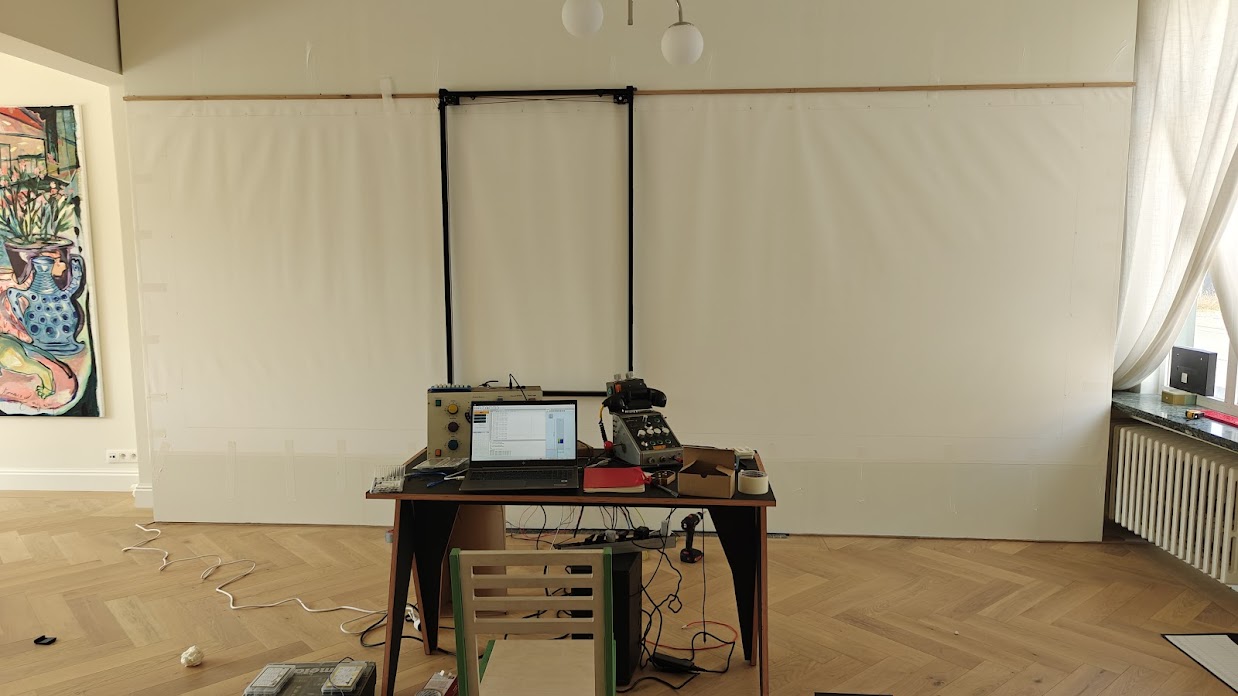Performance
I swapped my studio for a pop-up studio in Scheldewindeke, where I did a 3-day performance with Conrad Willems. Starting from a blank canvas, Conrad and I worked for 18 hours to fill this canvas over the course of three days. We both had our own approach. Conrad draws his lines using his pen and his hands, while I use an inermediate step. I use code to describe what I want to see, and a robot to draw it.
The robot
The robot is a pen plotter. I've had one since 2015, but it was limited to A3. Obviously I would need bigger. Having looked at the commercially available options and the DIY options, I firtst tried the vplotter cable hanging options, but they are not at all what I was looking for.
I switched to a flatbed design, and added extra motors along the belt chain for extra power. In the end, and some testing and 3D printing later, I had a working upright flatbed plotter that can draw up to about 80 cm wide and 180cm high.
The canvas
I wanted it to span a bigger canvas. We wanted to take up quite some space with the performance. To achieve our goal I settled for manually displacing the bot at some times in the horizontal space, made easy by a top ruler.

The code
The code was written as a performance, with the robot executing the code being my instrument in the performance. I regularly do livecoding performances. I connected the robot to my livecodi ng system, but it was way to slow to be used in a rhythmically performative track. The drawing previewing, made easy by vsketch, was important to plan what I would be doing, as we (Conrad and I) did not have a plan other than use each others drawing as a start.
The Collaboration
Making technology interacting with humans, keep the human in the loop, Human-Computer-Interaction Art.
Technology is my source material, I like to built instruments with it, opening up new ways of creating. I always look for a place where tech can augment, not replace the human. (opposed to the manifesto's of AI companies owned by billionaires)
The risk, the price
This work was an ongoing exploration of how we could collaborate. But we also had a mission to create a nice piece that the visitors could support and hang on the wall. As the work itself is a performance, we did not know where we would end up. Thus we divided the work in a grid. 16x4 A3 pieces that visitors could buy in a rusing price mechanism. The less drawing there was, the cheaper the price. Thus people would buy a cheap, but empty piece or a more advanced piece that already had a clear direction, later on in the sale process. Each piece sold would increase the price. The more risk you took, by buying an early piece, the cheaper it was.
The parts
The pieces we cut from the paper become standalone work, but they come from a bigger picture. This legacy is not always clear to the viewer. Isolating the A3s from the big paper creates interesting new lines and shapes. Even though it was virtually defined beforehand, the absence of a grid during the creation of the piece made us still think of it as one piece.
The work
Try zooming the image below like a map to explore the fine details of the work.
the future
The work is done, but we still have parts for sale. The risk is gone, so there is a first come first served and fixed price policy now. Please send an email to ask about availability and pricing. Have a look in detail below.
